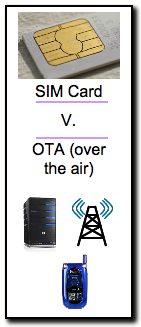|
|

|
Heuristic Evaluation of SIM card v. Network for Provisioning and Content Management
OverviewDuring the Sprint Nextel merger, Sprint evaluated the business justification for moving from a Network approach for provisioning and content management to the CSIM card found in carriers such as AT&T and T-Mobile, and the IDEN devices at the time. Critical to the evaluation was the impact to the user experience, particularly to those customers that would need to transition from their current phones to ones with a SIM card. This project was also politically charged, and therefore the unbiased assessment of the user experience group was a key input to the final decision.
Research Design

While the comparison stimuli were clear, the technical details were not so simple. As such, our evaluation method started with a functional requirements gathering exercise from which we extruded the impact to the user experiences. Tasks and constructs we utilized during our investigation included:
- Identify the critical user experience scenarios using task analysis and interviews with technology SMEs.
- Develop a scoring system that supported a clear decision to change or remain with the current methodology.
- Identify the key user metrics or constructs that would guide the decision process. The ability to control different aspects of the process, and the speed of accomplishing those tasks, were chosen as those metrics.
- Tasks were divided into those that impacted provisioning v. managing content.
- Weight of the tasks was also critical in the overall assessment.
The table that follows is a small piece of the analysis table we used to assess the two functional areas (manage content and provision), tasks (both primary and supporting), user variables (control and speed), and the comparison variable (CSIM v. Network). Note that the data is provided as an example and is not necessarily what we found.
|
CONTROL |
|
SPEED |
| Task Type |
Primary Tasks |
CSIM |
Network |
|
CSIM |
Network |
| Manage content |
Get Contact Scenarios |
|
|
|
|
|
| Get contacts from legacy iDEN or Sprint to DORr0: requires store visit |
0 |
0 |
|
0 |
0 |
| Get contacts from DOrA to DOrA and future methods |
5 |
5 |
|
5 |
5 |
| More primary tasks follow.... |
|
|
|
|
|
|
|
|
|
|
|
|
Supporting Tasks |
|
|
|
|
|
| Provision |
I am a new customer to Sprint (can use self-activation wizard) scenarios |
|
|
|
|
|
| New User activation: Good credit: Brief triple-tap experience |
0 |
0 |
|
0 |
0 |
| New User Activation: bad credit - Potential for visit with rep |
0 |
0 |
|
-3 |
-3 |
| More secondary tasks follow.... |
|
|
|
|
|
|
|
|
|
|
|
|
Weighted Totals (data intentionally removed) |
X |
X |
|
X |
X |
Accomplishments

- Our team of two received an Excellence award for our effort to deliver a user-centered answer in a timely fashion.
Building on That

The user experience team's recommendation was built on a number of factors besides the user experience, including cost and processes that would be inherent in the transitioning to new technologies. The evaluation was also built on certain assumptions about progress in OTA technology, existing SIM technology, and changing task scenarios. While the recommendations from our team were only a part of the greater assessment, adding specific statements about the quality of user experiences needed to maintain and improve user experiences with the chosen technology would have furthered user experience advocacy within the company. A lesson learned for the next time around.
Skills

- Willingness to do something different
- Requirements gathering
- Interviewing SMEs
- Task analysis
- Multiple data type synthesis
- Scale/User Experience measurement design
- Timely delivery
- Leadership, persuasion, and driving towards team consensus
Back to Portfolio Highlights
|
More...
Heuristic Evaluations
|

